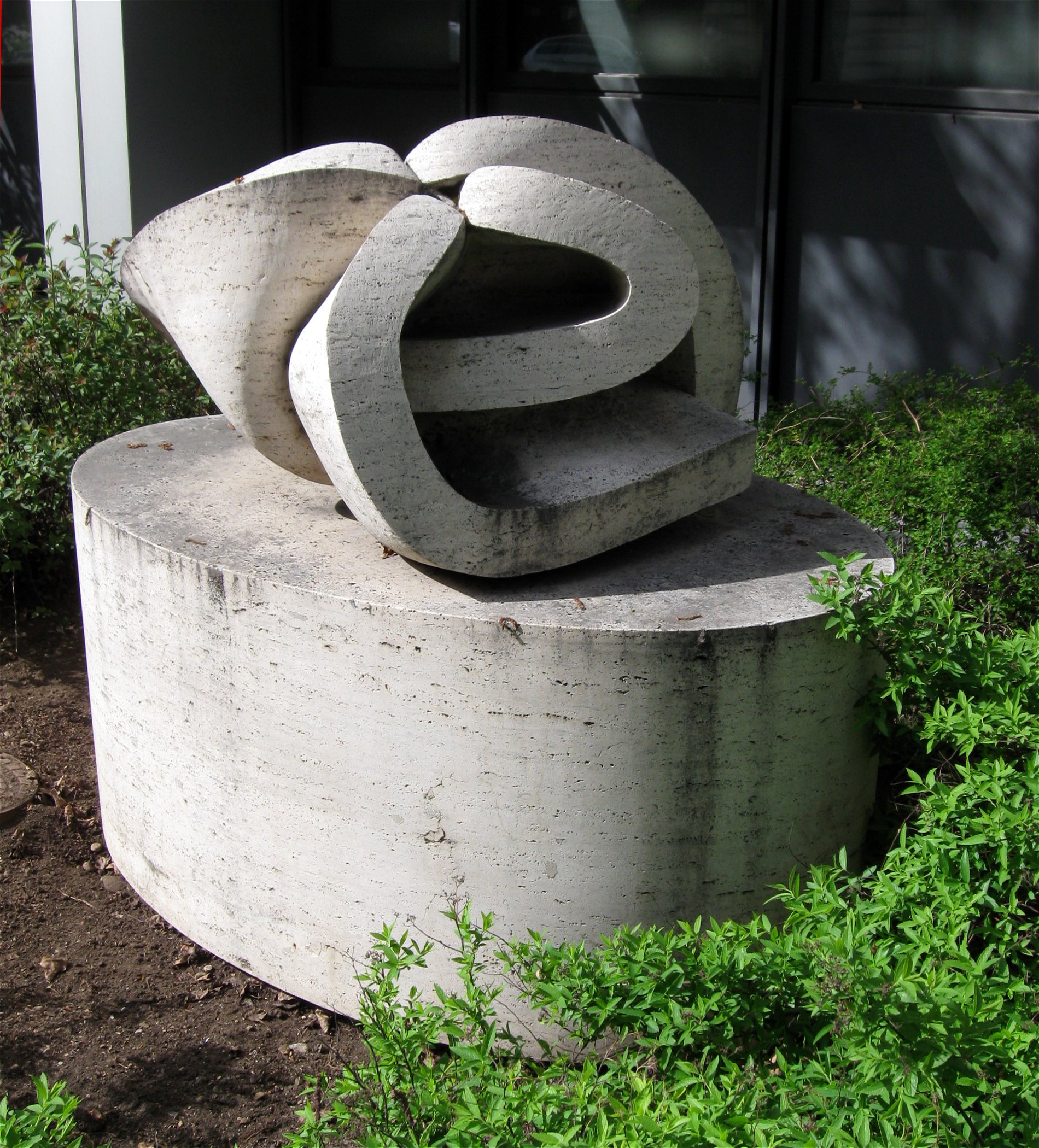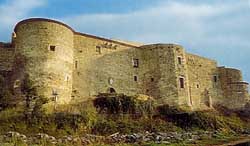|
Renzo Eusebi
Renzo Eusebi (born 18 April 1946 in Montalto delle Marche), Italian painter, sculptor of contemporary art. He is co-founder of the artistic movements of Transvisionismo (1995) and GAD (Dialectical Aniconism Group-1997). Biography He was born in Patrignone, a hamlet of Montalto Marche on 18 April 1946. In 1962 he attended the artistic high school in Rome and became friends with Sante Monachesi. He engages in the bas-relief in plaster, uses the spatula, creates a series of paintings obtaining a crushed painting. From the 70s to today, he has been present with his works in numerous personal and collective exhibitions and his artistic itineraries. In the 80s, he devoted himself to the search for an abstract surrealist painting, where they intertwine spirals from which geometric shapes of red, black, yellow and blue colors emerge, images and primary colors. In the 90s, he is a founding member of "transvisionism", an artistic movement born in Castell'Arquato (PC) and G.A.D. Dialecti ... [...More Info...] [...Related Items...] OR: [Wikipedia] [Google] [Baidu] |
Montalto Delle Marche
Montalto delle Marche is a ''comune'' (municipality) and former Latin catholic bishopric in the Province of Ascoli Piceno in the Italian region Le Marche, located in the hilly area that goes from the Adriatic cost to the Sibillini Mountains, at a distance of about south of Ancona and about north of Ascoli Piceno, with a population of 1 991 inhabitants. The municipal territory covers a 34 km² area. The municipality of Montalto is organised in a central town (Montalto) and three hamlets: Porchia, Patrignone, and an urban agglomeration in "c.da Lago" (located in Valdaso, along the Aso river). Montalto delle Marche is still structured around the medieval village. Along the walls, there are three main gates who provide the access to the central fortification, which is divided into three main areas: the Cassero, the Peracchia and Piazza Umberto I. The modern part of the city is located on the northeast side, and includes the main square (Piazza Sisto V) and the monumental Cat ... [...More Info...] [...Related Items...] OR: [Wikipedia] [Google] [Baidu] |
Contemporary Art
Contemporary art is the art of today, produced in the second half of the 20th century or in the 21st century. Contemporary artists work in a globally influenced, culturally diverse, and technologically advancing world. Their art is a dynamic combination of Medium (arts), materials, methods, concepts, and subjects that continue the challenging of boundaries that was already well underway in the 20th century. Diverse and eclectic, contemporary art as a whole is distinguished by the very lack of a uniform, organising principle, ideology, or "-ism". Contemporary art is part of a cultural dialogue that concerns larger contextual frameworks such as personal and cultural identity, family, community, and nationality. In vernacular English, ''modern'' and ''contemporary'' are synonyms, resulting in some conflation and confusion of the terms ''modern art'' and ''contemporary art'' by non-specialists. Scope Some define contemporary art as art produced within "our lifetime," recognising tha ... [...More Info...] [...Related Items...] OR: [Wikipedia] [Google] [Baidu] |
Patrignone, Montalto Delle Marche
Patrignone is a village in Marche, central Italy, administratively a frazione of the comune of Montalto delle Marche, province of Ascoli Piceno. At the time of the 2001 census its population was 130. . Patrignone is about 2 km from Montalto and 33 km from Ascoli Piceno
Ascoli Piceno (; la, Asculum; dialetto ascolano ...
[...More Info...] [...Related Items...] OR: [Wikipedia] [Google] [Baidu] |
Montalto Marche
Montalto delle Marche is a ''comune'' (municipality) and former Latin catholic bishopric in the Province of Ascoli Piceno in the Italian region Le Marche, located in the hilly area that goes from the Adriatic cost to the Sibillini Mountains, at a distance of about south of Ancona and about north of Ascoli Piceno, with a population of 1 991 inhabitants. The municipal territory covers a 34 km² area. The municipality of Montalto is organised in a central town (Montalto) and three hamlets: Porchia, Patrignone, and an urban agglomeration in "c.da Lago" (located in Valdaso, along the Aso river). Montalto delle Marche is still structured around the medieval village. Along the walls, there are three main gates who provide the access to the central fortification, which is divided into three main areas: the Cassero, the Peracchia and Piazza Umberto I. The modern part of the city is located on the northeast side, and includes the main square (Piazza Sisto V) and the monumental Cat ... [...More Info...] [...Related Items...] OR: [Wikipedia] [Google] [Baidu] |
Rome
, established_title = Founded , established_date = 753 BC , founder = King Romulus (legendary) , image_map = Map of comune of Rome (metropolitan city of Capital Rome, region Lazio, Italy).svg , map_caption = The territory of the ''comune'' (''Roma Capitale'', in red) inside the Metropolitan City of Rome (''Città Metropolitana di Roma'', in yellow). The white spot in the centre is Vatican City. , pushpin_map = Italy#Europe , pushpin_map_caption = Location within Italy##Location within Europe , pushpin_relief = yes , coordinates = , coor_pinpoint = , subdivision_type = Country , subdivision_name = Italy , subdivision_type2 = Region , subdivision_name2 = Lazio , subdivision_type3 = Metropolitan city , subdivision_name3 = Rome Capital , government_footnotes= , government_type = Strong Mayor–Council , leader_title2 = Legislature , leader_name2 = Capitoline Assemb ... [...More Info...] [...Related Items...] OR: [Wikipedia] [Google] [Baidu] |
Sante Monachesi
Sante Monachesi (1910–1991), was an Italian painter belonging to the modern movement of the ''Scuola romana (Roman School)'' and founder in 1932 of the ''Movimento Futurista nelle Marche (Futurist Movement of Marche)''. Life and career Monachesi studied at the ''Centro Sperimentale di Cinematografia'' (Experimental film centre or Italian National film school) in Rome. In the 1930s he embraced Futurism with spiralist and diagonal shapes both in painting and in sculpture, experimenting with aluminium in a mobile light. An important representative of ''Aeropittura'' (Aeropainting), in 1936 he exhibited at Biennale di Venezia and in 1937 at the World Expo of Paris. Immediately after World War II, Monachesi did expressionist and fauve painting, also as a member of the ''Scuola Romana'', becoming part of the group of "Balduina" with David Grazioso and Ferdinando Bellorini, but it was especially in plastic sculpture that his research became innovative. He explored new materials ... [...More Info...] [...Related Items...] OR: [Wikipedia] [Google] [Baidu] |
Giorgio Di Genova
Giorgio Di Genova (23 October 1933 – 25 July 2023) was an Italian art historian, critic, and curator, mostly known for being the author of '' History of Italian Art of the Twentieth Century''. Biography Giorgio Di Genova was born in Rome on 23 October 1933. He graduated in History of Art at La Sapienza University of Rome with a dissertation on Silvestro Lega. He then became a member of the Italian Communist Party, only to leave after the Hungarian Revolution of 1956. In 1975 he founded the quarterly magazine ''Third Eye'', published by Bora in Bologna, which he edited until 2006. In 1984 he was the curator of the Italian Pavilion at the 41st edition of the Venice Biennale, where he invited Antonio Bueno, Mario Padovan, and Novello Finotti to exhibit. In 1993 he was one of the organizers of the 12th Rome Quadriennale. In 1980 he was appointed Artistic Director of the National Biennial of Contemporary Art in the Province of Rieti. The first edition, ''Generation Twenties'', was ... [...More Info...] [...Related Items...] OR: [Wikipedia] [Google] [Baidu] |
Marta Lock
Marta may refer to: People * Marta (given name), a feminine given name * Märta, a feminine given name * Marta (surname) :István Márta composer * Marta (footballer) (born 1986), Brazilian professional footballer Places * Marta (river), an Italian river that flows into the Tyrrhenian Sea * Marta, Lazio, a ''comune'' in Italy * Marta, Nepal, a village development committee Arts and entertainment * ''Marta'' (film), a 1971 Spanish film * "Marta" (Ricardo Arjona song), non-charting * "Marta", a song by Alejandra Guzmán, from the album ''Indeleble'' * "Marta" (Nena Daconte song) a song by Nena Daconte, No.6 in Spain * "Marta, Rambling Rose of the Wildwood", 1931 song by Arthur Tracy * "Marta," a song composed by Moisés Simons MARTA * Metropolitan Atlanta Rapid Transit Authority, the principal rapid-transit system in the Atlanta metropolitan area * Mountain Area Regional Transit Authority, the third largest regional transit agency in San Bernardino County, California * ... [...More Info...] [...Related Items...] OR: [Wikipedia] [Google] [Baidu] |
Lamezia Terme
Lamezia Terme (), commonly called Lamezia, is an Italian city and ''comune'' of 70,452 inhabitants (2013), in the province of Catanzaro in the Calabria region. Geography Lamezia is located on the eastern border of the coastal plain commonly called Piana di Sant'Eufemia, which was created by drying a wide marshy area. The municipality borders with Conflenti, Curinga, Falerna, Feroleto Antico, Gizzeria, Maida, Calabria, Maida, Martirano Lombardo, Nocera Terinese, Platania, San Pietro a Maida and Serrastretta. History The municipality of Lamezia Terme was formally created on 4 January 1968. Its territory includes those of the former municipalities of Nicastro, Sambiase and Sant'Eufemia Lamezia. Nicastro Nicastro's origins trace back to the 9th century, when Calabria was part of the Byzantine Empire, when a fortress called ''Neo Castrum'' ("New Castle") was created. A great Benedictine abbey, St. Eufemia, was founded here in 1062 by the Normans, Norman count Robert Guiscard. It ... [...More Info...] [...Related Items...] OR: [Wikipedia] [Google] [Baidu] |
Pieve Di Cento
Pieve di Cento ( Bolognese: ; "parish of Cento") is a ''comune'' (municipality) in the Metropolitan City of Bologna in the Italian region Emilia-Romagna, located about north of Bologna. History The origins of the town date back to the upper medieval period, whereby a town was established around the local church, which had the title of "Pieve". In fact, Pieve di Cento had the only church with a baptistery in its rural area, still known as Centopievese, until 1378. This meant that all the other churches nearby were under its jurisdiction. The Pieve is the current Collegiate Church of Santa Maria Maggiore, which received its title in the Middle Ages and retained the title even with the closure of its Chapter ordered by the Council of Trent. In 1376, by a decree of the then Bishop of Bologna Bernardo de Bonneville, who was also a native of the area, the "Pieve" became known as Pieve Di Cento. This was also to be distinguished from the neighbouring town of Cento, which was given ... [...More Info...] [...Related Items...] OR: [Wikipedia] [Google] [Baidu] |
Vibo Valentia
Vibo Valentia (; Monteleone before 1861; Monteleone di Calabria from 1861 to 1928; scn, label= Calabrian, Vibbu Valenzia or ) is a city and ''comune'' (municipality) in the Calabria region of southern Italy, near the Tyrrhenian Sea. It is the capital of the province of Vibo Valentia, and is an agricultural, commercial and tourist center (the most famous places nearby are Tropea, Ricadi and Pizzo). There are also several large manufacturing industries, including the tuna district of Maierato. Very important for the local economy is Vibo Marina's harbour. History Vibo Valentia was originally the Greek colony of Hipponion ( grc-gre, Ἱππόνιον). It was founded, probably around the late 7th century BC, by inhabitants of Locri, a principal city of the Italian Magna Graecia, south of Vibo Valentia on the Ionian Sea. Diodorus Siculus reports that the city was taken in 388 BC by Dionysius the Elder tyrant of Syracuse, who deported all the population. The population came back ... [...More Info...] [...Related Items...] OR: [Wikipedia] [Google] [Baidu] |


.jpg)
